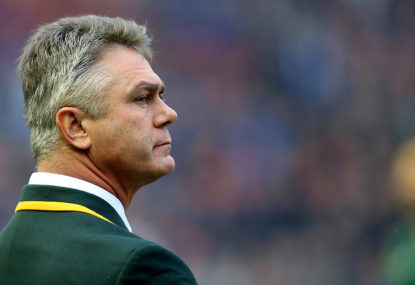Last Saturday the Springboks showed massive character and a truckload of courage to step out of their shells and play a game their supporters have always believed they can play.
But as beautiful as the change in mindset was, Heyneke Meyer and his charges know that if they are to evolve the Springbok attack they will need to assess the strengths and shortcomings of their current showings and build on what works for them.
It sounds like a simple thing to do, but nothing could be further from the truth. Constructing a truly remarkable attacking game is tricky, it requires a lot of thought.
It is not just about deciding what to do and where, it is also about recognising what types of players you have available and what skill set each of these players possess.
The thing about the Springboks is that for so long have they played a game that relies on no real attacking stratagem. It takes time, practice and patience to create one.
The good thing though is that once they have an idea of what type of game they want to play it will be easy to adapt as new players come into the side. It stands to reason that you can’t play the exact same type of game over and over with a plethora of different players. Each player is unique and brings something else to the table.
The key is to build a game plan around the players and not choose players according to the game plan.
So let’s start with the flaws of the current Springbok attack stratagem.
Passing the ball to a forward standing five metres away, expecting him to make metres and retain possession every single time won’t work, and I’ve noticed this pattern in Heyneke Meyer’s plan.
Meyer believes that once you soften the defence up at the front and launch a quick backline ball afterwards it will catch the opposition off guard. Now this might work a few times but it won’t fool the opposition on every occasion.
The danger to this technique is that players very often get isolated and lose the ball to a turnover. For some reason the ball carrier has the tendency to begin running up the field before changing direction back toward the heavy traffic. Eben Etzebeth and Tendai Mtawarira are especially guilty of this.
What’s worse is that after this has occurred and the ball does find its way to the backline, the move usually stops in its tracks because the opposition saw it coming from last Thursday.
As I said before, every player brings a different game to the field. Each player has his strengths and weaknesses that should be taken into account when planning an attack. The Springboks should starts using their big forwards out wide, rather than using them in close proximity.
The Boks did this last year at Ellis Park.
In Bryan Habana’s first try, Duane Vermeulen assumed a position between Jean de Villiers and Habana. He then recognised the mismatch in the All Black defensive line, burned Ma’a Nonu on the inside and supplied Habana to cross over.
In the second try, another loose forward, this time in the form of Francois Louw, stood between Habana and Jacques Engelbrecht. Louw then took up the ball, drew in Conrad Smith and Kieran Read and performed in amazing offload for another try.
That is two tries from two forwards who created something out of nothing in the midfield.
Of course that wasn’t the only two occasions this happened. Who could forget Eben Etzebeth outsprinting Ben Smith down the right wing almost resulting in a try for JJ Engelbrecht?
What I’m trying to advocate here is that while it is effective using the Bok forwards at close range, they, like the All Blacks, also possess the ability to draw defenders out wide and create space for the back three.
Of course when embracing this tactic you will need to use the right Bok forwards.
No disrespect intended, but using Jannie du Plessis out wide would be suicide. Instead they must use more mobile, skilled forwards in the mould of Bismarck du Plessis, Duane Vermeulen, Eben Etzebeth, Francois Louw and Marcell Coetzee.
When the Boks mix this sort of approach with the current one the results could be terrific.
What the Springboks must also learn is that an offload can make all the difference, putting players into space while playing wide. The forwards should run off 9, 10, 12 and 13 like the All Blacks do.
The Springboks possess the very best ball carriers in the world. Utilising them in various ways will add to their unpredictability.
Also, like the All Blacks do with Julian Savea, the Boks should start using Cornal Hendricks off 10 or 12. This will ensure a bit more punch, and when done correctly may even break the line as it did in Wellington two weeks ago.
The Springboks have the potential to become a great attacking team, but for them to become this team they need to be granted the opportunities to practice this game. It does not help that they run the opposition ragged in one game and kick them to submission the next.
The Newlands Test was testament to how effective the Boks can be on attack. In the entire game the side only performed two box kicks. The last time that happened I probably wasn’t even born yet.





























































































